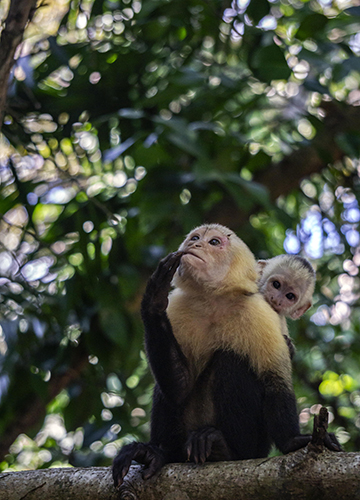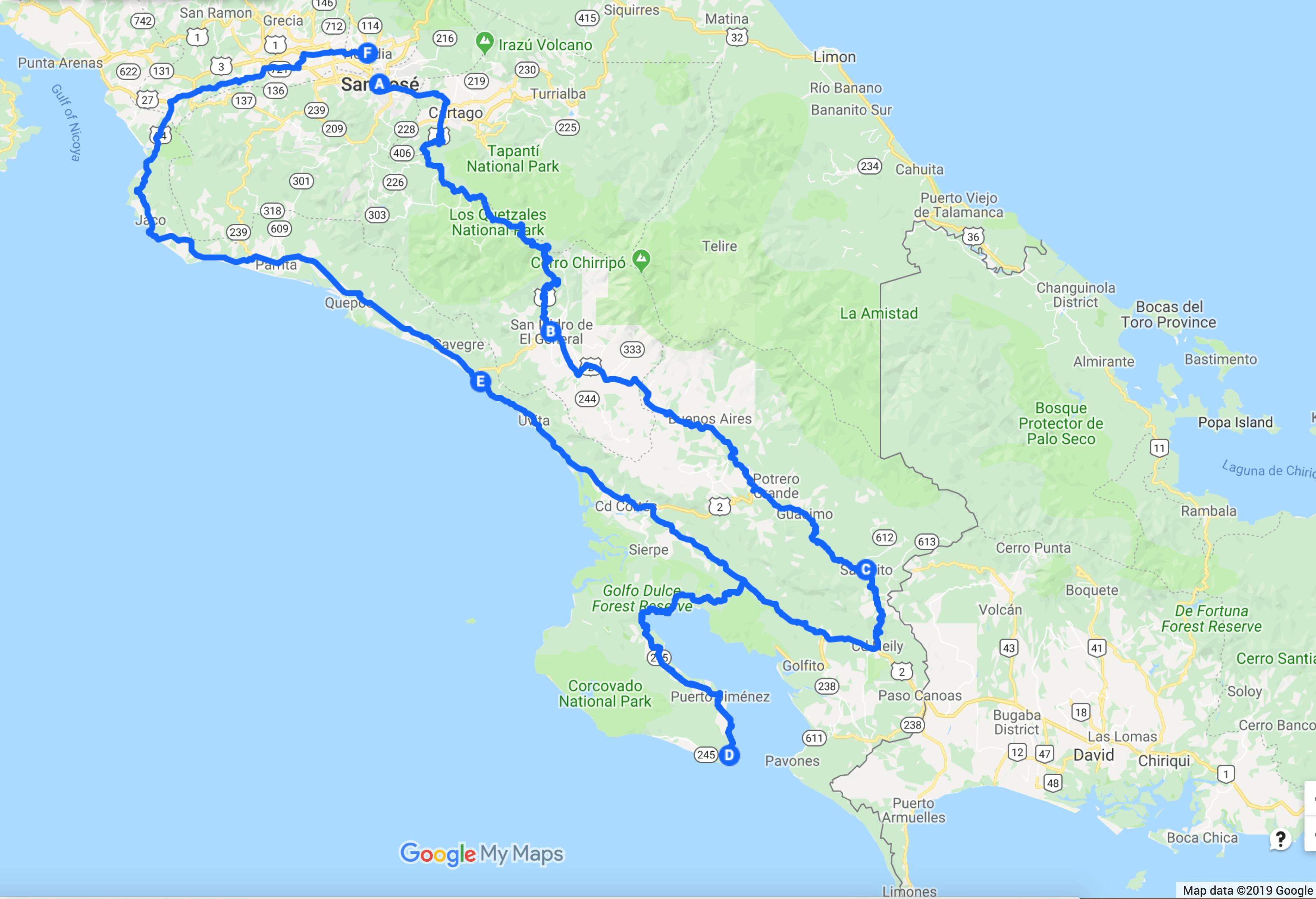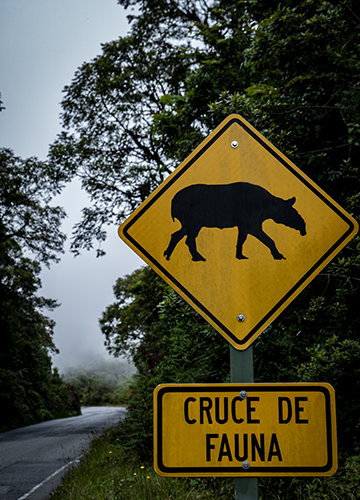Living Pura Vida
Travel ItineraryLaid-back Charm of Southern Costa Rica
San Isidro, San Vito & Osa Peninsula
Duration: 15 days
Distance Traveled: 1000 km
According to the Instituto Costarricense de Turismo (ICT), Costa Rica received over 3 million visitors in 2018 (almost half of which were travellers from the U.S.).
To assess how our recent Costa Rica vacation duration and budget measured up to the average trip to Costa Rica, we looked up the numbers provided by the Costa Rican Tourism Board. The average Costa Rica visit duration is estimated at 12 days. Our 15-day vacation was closer to the time typically spent in the country by Canadian and European visitors (14 and 17 days, respectively). This is not all that surprising given more generous vacation time in Canada and Western European countries.
Excluding the airfare, two of us exceeded the estimated average spending per tourist per day by about 25%.
Cost of transportation to and inside Costa Rica, was one of our major travel expenses (35%). This is despite our experimentation with flying Copa Airlines, instead of an U.S.-based carrier (which did cut our airfare cost in half). We also rented a car through a smaller and more affordable local Costa Rican Adobe Car Rental company (which, in itself, was an interesting experience and probably deserves a separate post).
- Lodging 35%
- Food 15%
- Transportation 35%
- Activities 15%
Only 15% of our budget was spent on Activities. One private half-day bird-watching tour at Los Cusingos and one-day guided Quetzal tour to Las Tablas (using our own vehicle) cost us $55 per person. We also found small group Nature walks (2-3 hours) with Lapa Rios Lodge very insightful and affordable ($30 per person).
Food (15%) is generally inexpensive in Costa Rica, unless you choose to dine at high-end restaurants in, say, Ojochal. It is a well-known gourmet hot-spot of the Southern Costa Rica. You can save big on food by dining at local eateries, shopping at farm stands along the road and ordering meals cooked by your local hosts. While grocery shopping in Costa Rica, avoid buying familiar (often imported) food brands, as they tend to be more expensive than domestic. Locally caught fish, whether it’s fresh, frozen and canned, is excellent. We were blown away by the variety of canned tuna fish sold on every corner. Costa Rican milk products and cheeses are also generally of good quality.
Lodging via home-sharing is generally affordable in the El General Valley (around San Isidro del General) along Route 2 (also called Interamericana High Way) and on the slopes of the Talamanca Mountains. It is pricier in San Vito and quite expensive along the South Pacific Coast, especially on Osa Peninsula.
South Costa Rica Trip Route
1. Boston – San Jose
8h 15min via Panama City
2. San Jose – San Isidro
3h (via Interamericana/Route 2)
3. San Isidro – San Vito
2h 30min
4. San Vito – Puerto Jimenez
2h 40min
5. Puerto Jimenez – Platanillo
2h 30min
6. Platanillo – San Jose
3h 40min
Trip Video
The Golden mantled howler monkey (Alouatta palliata) is one of the four primate species living in Costa Rica. It is the most common monkey and is remarkably vocal. The voices of a male howler can carry up to 3 miles!
This video captures a troupe of Osa Peninsula mantled howlers moving through the canopy of secondary rain forest as they forage on leaves.
You can observe their controlled head-first vertical descent along tree branches, a rather unique form of quadrupedal (using all 4 limbs) locomotion characteristic for these fascinating animals. The monkey will face the ground and walk down with both hands and feet grasping the support. Their prehensile tail capable of hold on branches, helps control the movements during the descent.
This mode of locomotion has only been described in a few non-claw anthropoids. It is an adaptation for more effective movement and foraging in discontinuous forest canopy with an abundance of lianas.
Memorable Eats and Drinks in Costa Rica
1. Lunch Tipico at Las Tablas (1km from the Panama boarder)
This meal al fresco, consumed while sitting on a trunk of a fallen wild avocado tree, was rather simple traditional blend of pork, rice & black beans wrapped into steamed banana leaves. Prepared for us by our nature guide’s wife especially for the Quetzal Tour, it was the absolute winner on this Costa Rica trip.
2. Mamalapa Cocktail at Lapapalapa Bar (Osa Peninsula)
Getting a refreshment can be a challenge amidst the wilderness on Osa Peninsula. Unless you just shake up your own drink! The Lapapalapa Bar at Lapa Rios ecolodge was a pleasant exception. If you happen to stay at Cabo Matapalo, try their Mamalapa cocktail as a starter. The original recipe was created by the founder of this unique National Geographic Lodge and represents a heavenly vodka-based blend of fresh passion fruit flesh and coconut cream.
3. Breakfast with a Mountain View (Platanillo)
On our last day in Costa Rica, we woke up early to a gorgeus sunrise in Costa Rica mountains. Within one hour, we had a tastefully appointed table in the dining room of Quinta Heliconia. Another couple had their own dining spot on the deck. A light and refreshing breakfast, featuring local papaya and pineapple fruit cocktail and French dark roast coffee, was exactly what we needed before heading out on the last trail hike of the trip.
Cloud Forest Mountains
Driving through the misty Talamanca Mountains along the Interamericana Road is a road experience like no other. Gradually, the temperatures drop down and the wind-driven clouds start obscuring the view over the mountain range. We found this important ecosystem of Costa Rica, at least, as fascinating as the upcoming Pacific and Pre-montane Rainforests. San Isidro Del General offers a unique opportunity to visit Los Cusingos Neotropical Bird Sanctuary, the enduring legacy of Alexander Skutch.

San Vito Botanical
Las Cruces Biological Station and its Wilson Botanical Garden and forest trails were our primary destinations in the Coto Brus region of Southern Costa Rica. However, a guided day tour to the remote protected area of Las Tables near Panama boarder, made this trip even more memorable. If you are looking for an almost guaranteed sighting (with good photo op) of the iconic Resplendent Quetzal, look no further.

Osa Peninsula
Osa Peninsula is one the arboreal biodiversity and botanical treasures of Costa Rica. Let not the remoteness and underdeveloped infrastructure of this corner of the country scare you off. Embrace its ” roughness” as a part of the “off-the-beaten-path” and “true green” travel experience. Here, you will discover places where even endangered animals, such as Squirrel and Spider monkeys, are not impossibly elussive in the wild. On Osa, both active and “lazy” bird-watching are superb and the King Louis Waterfall, a hidden gem of Costa Rica, is within a walking distance.



